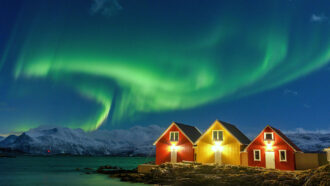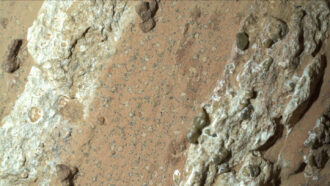Planets
-
 Space
SpaceThe biggest discoveries of Voyagers — NASA’s most distant explorers
Voyager 1 and 2 left Earth in 1977 to fly by the outer planets. Nearly 50 years later, these spacecraft are still transforming our knowledge of space.
By Sarah Wells -
 Planets
PlanetsA peek into a stellar nursery has revealed six baby giant worlds
Images of six Jupiter-sized worlds taken by the James Webb Space Telescope offer clues to how planets and stars form.
By Adam Mann -
 Space
SpaceThe moon has new tales to share, some from its secretive far side
Ongoing observations and new lunar rock samples, including the first from its far side, should point to how both the moon and our Earth evolved.
By Liz Kruesi -
 Planets
PlanetsScientists Say: Theia
Clues about this ancient protoplanet's catastrophic end may have been entombed in Earth's lower mantle for billions of years.
-
 Planets
PlanetsExperiment: Make your own craters!
Let’s make our own craters in cocoa and flour to learn how these features form throughout the solar system — and why they’re different sizes.
-
 Planets
PlanetsAnalyze This: Jupiter’s Great Red Spot is shrinking
If the windstorm keeps dwindling, the Great Red Spot could someday disappear — like an earlier spot observed in the 1600s.
-
 Physics
PhysicsScientists Say: Magnetosphere
This magnetic field encapsulates our planet, sheltering us from damaging energetic threats posed by the cosmos and our own sun.
-
 Planets
Planets‘Percy,’ NASA’s rover, finds its first hint of ancient life on Mars
The robot examined a Mars rock containing organic compounds and “leopard spots.” On Earth, such spots usually come from microbial life.
-
 Planets
PlanetsHere are 5 exoplanet mysteries the James Webb telescope could help solve
This space telescope could reveal much about the formation, makeup and evolution of distant exoplanets.
By Elise Cutts -
 Planets
PlanetsActive volcanoes may be common on Venus
Researchers took a new look at decades-old images from NASA’s Magellan spacecraft. These now suggest volcanic activity is widespread on the planet.
By Adam Mann -
 Planets
PlanetsPluto’s heart may hide the rocky wreckage of an ancient impact
A huge, rocky remnant beneath Pluto’s surface could explain the odd location of Sputnik Planitia — its famous heart-shaped basin.
By Adam Mann -
 Planets
PlanetsThe desert planet in ‘Dune’ is pretty realistic, scientists say
Humans could live on the fictional planet Arrakis from Dune. But thankfully giant sandworms probably could not.